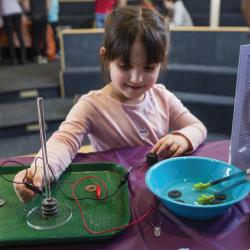Source Institutions
Source Institutions
Add to list Go to activity
Activity link broken? See if it's at the internet archive

The Let's Do Chemistry "Build a Battery" activity lets participants learn how batteries work and how materials behave, change, and interact by building their own simple battery out of metal and felt washers. Learners can use their battery to power an LED or a buzzer. This style of battery is similar to the original "voltaic pile" battery. Activity includes a facilitation guide with potential misconceptions, relevant science infosheets with real-world connections, table sign, and activity training video. All public-facing materials also available in Spanish.
- 5 to 10 minutes
- 5 to 10 minutes
- $10 - $20 per group of students
- Ages 6 - adult
- Activity, Model
- English, Spanish
Quick Guide
Materials List (per group of students)
- Permanent marker and labels
- 2 LED flashlights (one with working batteries inside, one without)
- Acrylic stand
- Felt disks
- 3/4 inch standard zinc washers (8, save extras)
- 3/4 inch copper washers (8, 1 with a length of copper wire attached, save extras)
- Bowl
- Vinegar
- Tray
- Small, grippy tongs to hold felt washers
- Paper towels
- Microfiber cloth or sponge
- 2 wires with alligator clips on each end
- Large LED diodes (Squishy Circuit style)
- Buzzer
- Marker and labels
Subjects
-
Engineering and Technology
-
Engineering
- Chemical Engineering
-
Engineering
-
Physical Sciences
-
Energy
- Energy and Power
-
Chemistry
- Chemical Reactions
-
Energy
Informal Categories
- Science Festivals Activity
Audience
Learning styles supported:
- Involves hands-on or lab activities
Other
Foreign language versions of this resource:
Components that are part of this resource:
- Activity Guide
- Activity Sign
- Facilitator Guide
- Copper Safety Data Sheet
- Build a Battery Image
- Vinegar Safety Data Sheet
- Zinc Safety Data Sheet
- Training Video
Access Rights:
- Free access
By:
Rights:
- Creative Commons: Non-commercial Share Alike (by-nc-sa), Sciencecenter, 2018
Funding Source:
- National Science Foundation, 1612482
